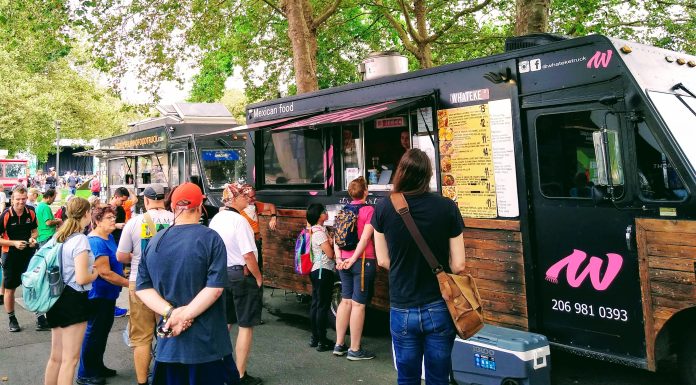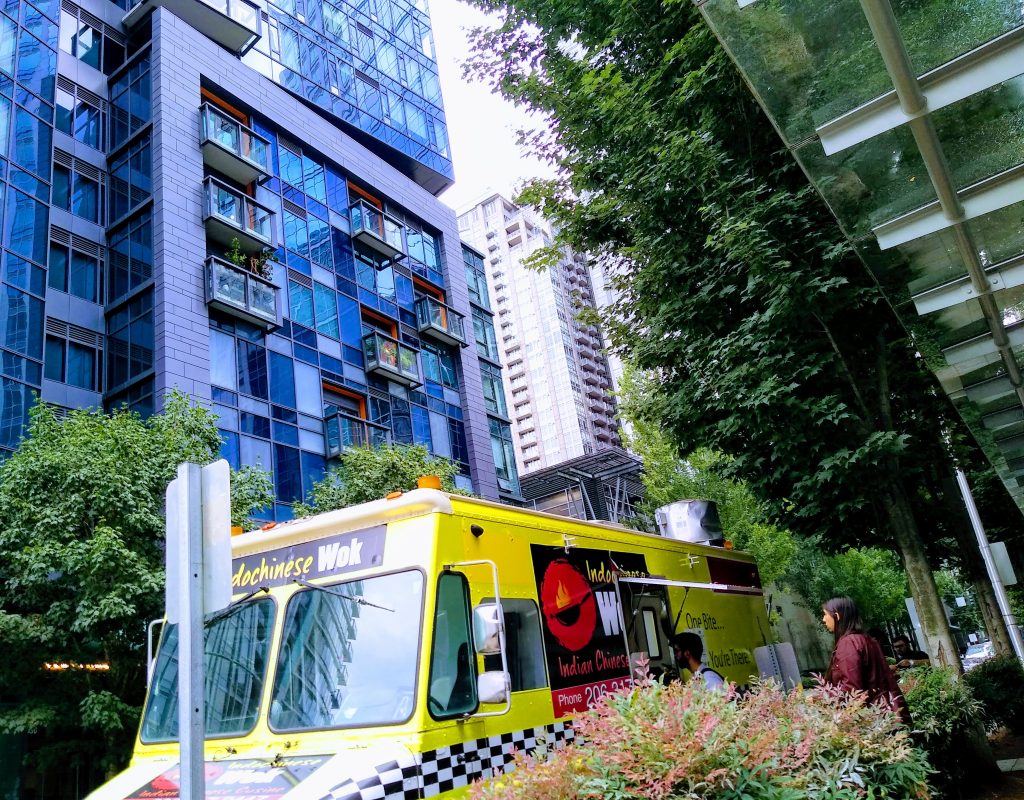
The City of Seattle is seeking to grapple with what the long-term implications of how Seattle residents expect to use public space following the impact of the Covid-19 pandemic. With streateries replacing public parking and some neighborhood streets slightly more accessible for walking and rolling, the Seattle Department of Transportation (SDOT) is trying to develop permanent regulations that will last for years to come. While many of those regulations are focused on these pandemic-era uses, the agency is also grabbing an opportunity to look at something that had been static for many years: regulations around where in the city food trucks can be parked.
In 2011, the Seattle City Council unanimously passed a law that allowed food trucks to operate on city streets. Prior to that, food vending was only permitted on private, off-street lots. At the time, there were vocal concerns raised among restaurant owners that an increase in food trucks on the street might be bad for nearby brick-and-mortal businesses. “Is this necessary? Is this something that the community needs? I would say the answer is no,” the owner of Rancho Bravo Tacos, Freddy Rivas Jr., told the Seattle Times in 2011.
So the ability to set up on the street came with a long list of restrictions. For instance, a food truck must be at least 50 feet away from any adjacent food service establishment, and no more than two food trucks can operate along any one side of a street.
There are also a great number of restrictions on food trucks that don’t have much to do with concerns about impacts on neighboring businesses. Food trucks have to be at least 1,000 feet away from a high school, and 50 feet away from a public park. Food trucks are also not permitted adjacent to the vast majority of the parcels in the city that are zoned low-density residential, including single family zones (recently renamed to neighborhood residential), residential small lot, or even low-rise zones.
Now as SDOT seeks to codify the current way public spaces are used, it’s proposing to loosen many of those restrictions that were imposed on food truck operations over a decade ago. Most notably, the requirement that trucks be 50 feet away from other food service businesses would be removed, as would the cap on the number of food trucks per block. The department may still impose a cap on a case-by-case basis, however, “depending on site conditions, and to ensure an appropriate balance between private activation use and public access and mobility,” according to the draft regulations.

The setback requirement from high schools would also be eliminated, though vendors would still need to notify any schools within 200 feet that they had applied for an on-street permit. And while the park setback requirement would go away, Seattle Parks and Recreation would still be able to deny permits for food truck vending within 50 feet of a park for a number of reasons, including “public safety or access within the park,” “the need to encourage park activation,” and conflicts between potential vendors and in-park concessionaires.
Earlier this year, legislation specifically aimed at clarifying rules around park vending separately passed the council, and the city expects to see more opportunities to grow small businesses via park vending moving forward as it invests money in economic resilience through the Jumpstart payroll tax, opportunities that presumably help fledgling food truck operators as well.
As for the city’s residential zones, SDOT does propose removing the current restriction that keeps food trucks away from the vast majority of residential zoning in the city. But the department would still retain discretion, like the Parks department, to deny permits to vendors who want to operate in those zones. Laid out, the considerations for approving permits in lower density areas include the “Street
Type as defined in Streets Illustrated; the neighborhood context and character including compatibility with the density of the built environment; nearby land uses; proximity to business districts or businesses; noise; odors; traffic conditions; and desirability of increased public activation.” Those are a lot of avenues for nearby residents to get vendors removed from their neighborhood.
So will this overhaul of regulations prompt a flood of food trucks that had previously been held back by siting restrictions? A more steady trickle is more likely. Last year, Eater Seattle detailed how onerous requirements for food truck operation, which had been adding costs to operations, were slowly getting reduced but remain incredibly burdensome. A requirement that every food truck prepare food in an off-site commissary was loosened in 2020, and the state legislature also made it easier for food truck permits valid in one jurisdiction to be used in another.
Fees to operate on the street are another matter. SDOT plans to increase the amount for a vendor to operate at a new location from the current $181 to $950, though that amount now includes a review fee that was charged separately. With the number of potential sites poised to dramatically increase, that could mean additional fees as the department reviews sites that hadn’t previously been considered for food trucks and potentially loops in other departments like Parks. Then the actual fee to use the street ranges from $478 for four hours in spots that are normally paid parking, and $108 for spots that are not. Especially in the case of street space the city normally gives away for free, these steep usage fees don’t really reflect a use that the city is supposedly trying to encourage.
Thus, it doesn’t look like these proposed changes are about to skyrocket Seattle to the front of the pack in encouraging food trucks on city streets. Food Truck Nation, a product of the U.S. Chamber of Commerce foundation, ranked Seattle #17 on a list of the country’s top 20 food truck cities. Researchers estimated that Seattle food trucks cost approximately $32,000 per year to operate, compared to just $5,410 in Portland. That cost could go down a bit if vendors are able to take advantage of some of the new changes in state law, but Seattle looks set to remain one of the least encouraging cities for mobile vending, even if more of the city is opening up to potential trucks.
You might see food trucks packed a little more closely in busy neighborhoods, and trucks parked in less isolated locations or even on a few quieter neighborhood streets. And while that’s not set to become a new food truck revolution that will take Seattle to Portland’s level, it has the potential to be a good thing, even if the City Council clearly shouldn’t stop there.
Ryan Packer has been writing for The Urbanist since 2015, and currently reports full-time as Contributing Editor. Their beats are transportation, land use, public space, traffic safety, and obscure community meetings. Packer has also reported for other regional outlets including BikePortland, Seattle Met, and PubliCola. They live in the Capitol Hill neighborhood of Seattle.

